An interview with Dr. Travis Zigler, Owner of Profitable Pineapple Ads.
My name is Dr. Travis Ziegler. I own an agency called Profitable Pineapple Ads. That’s not how I got my start, though. I’m actually an optometrist by trade, and so I graduated from the Ohio State College of Optometry in 2010 with my doctorate and my wife is also an optometrist. She graduated in 2011, and we actually practiced here in Columbus, Ohio, for my uncle for a couple of years.
But I felt an itch, a scratch, to do something else and I didn’t know what it was. So I did the three things you’re not supposed to do. I quit my job. I moved across the country from Ohio to South Carolina, and then I opened up two practices with my wife. And so we had two practices and I went from seeing six patients an hour to seeing one patient an hour.
And any entrepreneur knows that if you go from very busy to very bored, you have to do something else. And so I came across a course called Amazing Selling Machine back in 2015 and bought that course, took it, learned how to sell on Amazon, and we started our Amazon business at the same time we were starting these two practices.
And then once we kind of saw the Amazon business take off faster than the practices, our practices were doing really well too. But the Amazon business took off more like a hockey stick. We decided to sell our two practices in 2017 and go all in on this online space. Around that same time, we kind of started dabbling with helping other people with their advertising, and we had about 2 to 3 clients at that time.
And then we’re also building Eye Love as well, which was our brand that we started. It was all run dry. We eventually grew Eye Love to the point that we sold that in 2021, and then the agency we started officially in 2019. And so like I said, we were managing about 2 to 3 people and then we decided to take it seriously.
I brought on my two best friends to help me with that. And now here we are. We’re a team of about 11 people, eight full time and three part time, and we manage over 50 clients. And then we have a couple of other things. We help launch services as well. So we help brands launch from scratch, and we have done about 120 of those in the last year as well.
So that’s where we are today and I’m completely out of my business Eye Love now and I focus full time on Profitable Pineapple Ads.
The reason that any seller that’s online, or even a brick and mortar store, should sell on Amazon is the sheer volume of traffic. Amazon gets the majority of traffic online for online commerce.
Subscribe to the eCommerce newsletter for
top industry insights
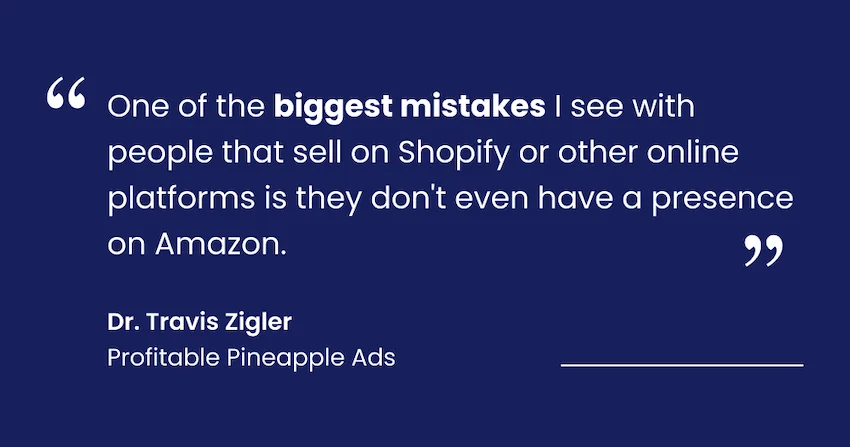
I think 50% of sales that are made online are made on Amazon itself. And so really making sure that even if you’re not focusing on Amazon, necessarily trying to grow on Amazon, just making sure you have a presence there. One of the biggest mistakes I see with people that sell on Shopify or other online platforms is they don’t even have a presence on Amazon.
This is the buyer cycle. If I see a Facebook ad, the first thing I do is I go over to Amazon to look. And the problem with that is if you’re not on Amazon and your buyer is going there to check first, they might buy a competitor that has a similar product to you instead of going back to your Shopify store and buying because with Amazon there’s less friction.
They already have your credit card information, your address, so that the buyer doesn’t have to put all that information in. They can go over to Amazon, click one button and it’s shipping to their house in two days. Whereas if it were on your website, it takes a lot more clicks and there’s a lot more friction there.
So even if you’re not going to focus on Amazon, if you still focus on Shopify, make sure you have a presence on Amazon to make sure you’re capturing that traffic as well.
The main way that people can differentiate your product on Amazon is just making sure your listing is optimized for Amazon. And the number one thing you can do for that is, in my opinion, reviews and ratings.
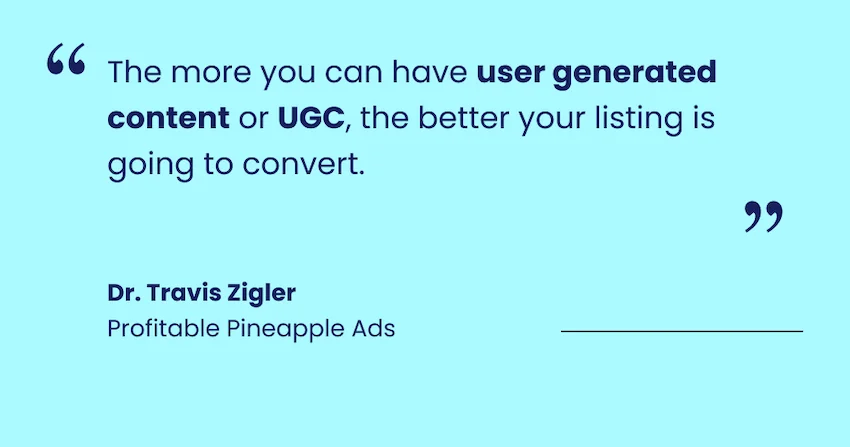
We are in a social proof society. They can’t feel, they can’t touch the product. And so social proof is key. So making sure you have four and a half stars and above on Amazon and then making sure you have multiple ratings. And when you’re getting those ratings, try to get people to leave pictures, try to get people to leave videos, because the more you can have user generated content or UGC, the better your listing is going to convert.
And then of course, to make the sales to get the ratings, we need to have great photos, and you need to have great copy. And in my mind, photos and ratings are the two most important. Copy is good, but I feel like photos tell a story better. So you can tell a story with your photos, and I recommend doing that.
Evoking emotion, focusing on the benefits to the end user. What pain does your product solve? Does it solve a pain, or are you trying to get somebody to heaven? Is it a pleasurable product? So what pain are you solving, or what kind of pleasure are you trying to bring? Those are the two things you want to focus on with the benefits of your product.
The easiest and most effective Amazon ad that you can create is a defensive ad, just around your brand name. So there’s two ways to do defensive ads on Amazon, your brand name, of course. Even if you are just starting out, advertising for your brand name is huge because people will start to search your brand name eventually.
They may not at the beginning, but as you start building your brand, as people start buying your product, people are going to search for your brand name as long as you have a high quality product, not just some other cookie cutter product from China. So make sure you differentiate your product with a high quality product, and make sure you’re creating an experience that no other product, no other seller, is doing.
The most effective way is to do a search ad for your brand name and then also do a product targeting ad on your listing. If you only have one product, it’s going to be a little harder to do that, but what you can do is multipack variations. So have a one pack, a three pack, and a six pack, and then have that three pack and six pack advertising on your listing to take up more of that product page.
Because if you don’t have your products on your own product page, your competitors are going to come in. So you’ve done all this work to get somebody on your product page and now your competitors are visible as well. But if you have defensive ads, product targeting ads, then your product will show all over your product page instead of theirs.
Amazon PPC is just simply advertising on Amazon. PPC stands for pay per click. And so what you’re doing is you’re advertising all over Amazon for search advertising. So when somebody pulls up the Amazon app on their phone, they put in a keyword to search.
So my example that I always give because we sell them, is eyelid wipes. So they’ll type in eyelid wipes into their phone in the search bar. And what you’re going to notice is the first two to five to probably going to be ten here in the near future are sponsored products.
So that’s an Amazon PPC search ad or a Sponsored Product Ad. There’s also ASIN targeting. So ASIN targeting: each product on Amazon has individual ASINS and those ASINS are just identifiers, and you can actually target other competitors in your space by targeting their ASIN with sponsor products, the Product Targeting Ads.
So those are the first two sections. You can target specific products and show up on their product listing or you can do search ads, which, when they type in whatever they’re searching for, you can show up for that as well. The second part is sponsored brands. Sponsored brands are things like headline search ads. These are the big banner ads that are at the top.
Those are also search ads. And so somebody searches for eyelid wipes, you have a big banner out at the top, and then you have a bunch of other search ads, which are just product listings and then sponsor brands also has videos. And so when somebody searches for a specific keyword, then your video will show up in the search results.
They also have product targeting for those as well. So you can show up on other people’s listings for that. And then finally, there’s sponsored display ads which help you show up all over the listing with more photos and videos and things like that.
The best way to scale Amazon PPC sales is to really focus on the 80/20. And I’m sure your listeners and viewers have heard of Pareto’s Principle, or the 80/20 principle. What that states is just 20% of your inputs create 80% of your outputs. And so Pareto examined this because he noticed that 20% of the seeds he planted in his garden produced 80% of the crop, 20% of the landowners own 80% of the land.
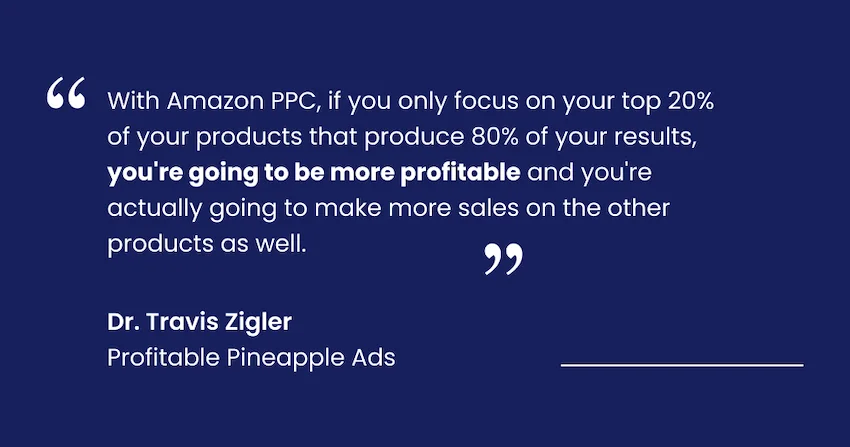
And so how does this apply to your Amazon business? Two ways. So with Amazon PPC, if you only focus on your top 20% of your products that produce 80% of your results, you’re going to be more profitable and you’re actually going to make more sales on the other products as well.
So if I took a look at anybody’s account and they have ten products, two of those products are producing 80% of their results. If they have 100 products, 20 of those products are producing 80% of their revenue. If they have 1,000 products, 200 or less of those products are producing 80% of their revenue.
So keep that in mind. When you’re planning for your budget with Amazon PPC, focus only on the top 20%. That’s the main thing that we do with the clients in our agency is we just focus on that top 20% of the products, and then what happens is you start spending out more profit and cash flow, which then you can use for the next products.
That’s how you build your brand, because then you’re also going to make more sales on those top 20%, which is then going to make your brand stick out more and then it’s going to overflow to your other products as well as long as your brand is in sync, it’s all one brand that’s cohesive and all the products are very complementary.
So the second thing is that you want to focus on the 20% of search terms, and ASINS, that are creating 80% of your results. So the first part was focusing on the top 20% of your products. And then what we’re going to do is we’re going to download your search term report inside of Amazon Campaign Manager.
When we download that search term report, we’re going to organize it by orders. And what you’re going to notice is that 80% of the revenue that’s generated from your PPC is from 20% of your search terms and ASINS.
So what are we going to do? We’re going to focus on those, because if we focus on those that are actually converting and they’re making the most sales for you, again, it’s going to increase your profit, it’s going to increase your sales velocity, it’s going to increase your conversion rate, which is then going to increase your organic ranking, which then increases your profit again.
So it’s this constant cycle. Amazon focuses on two things: sales velocity and conversion rate. Conversion rate is key because Amazon wants to show products that convert, because when you make a sale, they make a sale. Therefore they want products that convert a lot higher.
And then if you convert a lot higher, they’re going to show you higher in the rankings. They’re going to show you more with advertising, and then you’re going to get more sales, so sales velocity. It’s this loop that once you get it going, it’s a flywheel that keeps going.
I always recommend sponsored products, search ads. And so search ads, when we look at the data across all our clients, search ads are anywhere between 80 to 90% of their ads.
So this again, is when somebody types in a specific keyword into Amazon, “eyelid wipes” for example, and your product listing shows up at the top or the second or the third, depending on what you’re bidding. Search ads account again, for 80% to 90% of all our advertising. Search ads are going to bring you scale. Search ads are the 80/20 of Amazon advertising. The rest of it will bring you sales, but they’re not going to scale you as fast as those search ads are.
Now, there are always exceptions to the rule. We have one client that is 80% to 90% sponsor brands, those big headline banners and the videos. That’s actually what drives the majority of their sales. But search ads for the majority of our clients are what really scale. And then also ASIN targeting helps with impressions, so getting people to see your product and get eyeballs on it.
The number one mistake that I see Amazon sellers make when it comes to Amazon PPC is they follow too many strategies. There’s just too much going on in their account and they don’t know what they’re really doing after they try to implement all these strategies.
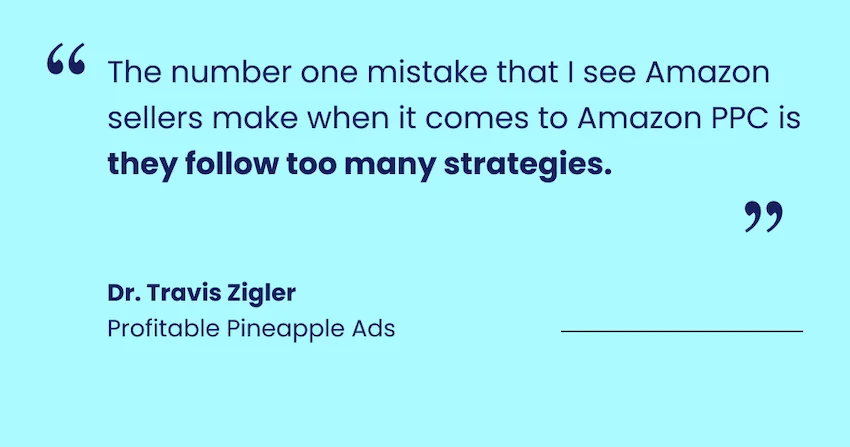
So they’ll try a strategy they learned on a podcast. Then they’ll go over here and take a course and then they’ll start applying that strategy. Then they’ll see a video somewhere else and then they’ll apply that strategy. And when you combine all these strategies, it kind of creates this mess in their account. And so that’s kind of the biggest mistake I see.
Is my strategy the only one that works? No, not at all. But ours is one strategy that works really well, and then there’s other strategies. But the key thing is just stick to one strategy that really resonates with you. Try that strategy and that strategy only for 3 to 6 to 12 months, and then if it’s not working, then you can switch to a different strategy.
When a seller is starting to run low on stock or they need to slow down sales, quote unquote, to make sure that they can get the next inventory in, it’s a very controversial subject, and a lot of people say don’t ever raise your price because it will kill your sales and it will hurt your listing.
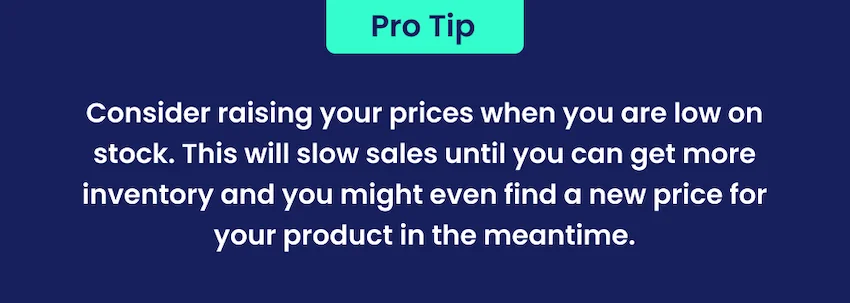
I’m of the opinion that I like to raise my price because it does two things. It will slow down sales a little bit. It will increase your profit a lot, but then you might find a new price in the meantime.
I’ll give you an example of this. We sold eyelid wipes for $14.97, and we sold about 150 to 200 of them a day. And what happened was there was a global shortage of an ingredient in our eyelid wipes and we were going to be out of stock for months if we didn’t do something about it. So we doubled our price to $29.97, which most people would say would kill your listing.
What happened was we went from 150 to 200 sales a day to about 75 to 100 sales a day, but we more than doubled our profit margin. We went from a profit margin of like $10 to a profit margin of $25.
So imagine with that, what you can do with your advertising as well. You can spend more on ads, you can spend more on external traffic as well. But we, of course, toned down ads. So what we do is we get just a little tighter on our ACOS (advertising cost of sale) targeting.
So let’s say with that product, we’re targeting an ACOS of about 70%. We raised the price and then we targeted a lower ACOS of about 40% to 30% until we kind of adjusted. So we’re maximizing profit, still making sales, that’s kind of the goal.
Then if we are to stock out, what we do then is we raise the price super high. So we’ll raise our price from $30 all the way up to $100. And then what Amazon does is it actually suspends your listing because it will say there’s a pricing error, we’ve suspended your listing. And then we’ll leave it suspended until it comes back into stock.
Once it comes back into stock, then what we’ll do is we’ll put it back down to the price it’s supposed to be and then Amazon will unsuspend it, and then you’ll get back to selling.
So a good ACOS, or advertising cost of sale, is all dependent on your brand and what you’re trying to accomplish. The reason I say it like that is because when I’m selling a product, I’m in it for the long term game. So when I’m determining the ACOS target that I want, I first calculate the break-even ACOS.
Break-even ACOS is just your profit margin. And so I’ll take my retail price that I sell it for, minus Amazon fees, and then I’ll take out the shipping and fulfillment, and then I’ll take out the product cost. So in the example of eyelid wipes, let’s say the eyelid wipes are $30. Amazon fees are about 15% of that. So that’s $4.50. So now we’re down to $25.50 and then let’s do $5 for pick and pack so we’re down to $20.50. And then the product costs, let’s just say it’s $5. So when I see the number of $15 of profit, I then take 15 divided by the top number 30. So that gives us a 50% profit margin because we’re making $15 on $30. I’m not putting PPC costs in there.
So that means I have a profit margin of 50%. My break-even ACOS is 50%. So I can spend up to 50% ACOS and still break even.
Now, my product is a consumable. So now I know my break-even ACOS, and I want to figure out my target ACOS. So with consumables, I actually go 10% to 20% to 30% above break-even ACOS.
So I will take a loss on that initial sale because I know my product is so good and high quality that they’ll come back to order more. And that’s just knowing your numbers. So we have about a 40% repeat customer purchase rate, which is very high, and so I’m willing to spend a lot more. I also know that our lifetime value is $320, so I’m willing to spend a lot more upfront to get a customer in the door because they’re going to buy my other products as well.
Now, if you’re selling a cheap plastic widget from China, I would go under because the whole goal for you is just cash flow. You’re not building a brand, you’re not building long term equity, you’re not building lifetime value. You’re just trying to sell off the rubber spatula unless you have a kitchen brand, of course. But you’re just trying to sell something.
So 50% is your break-even ACOS. I would go even 10 to 20% under it. And if that’s not sustainable for you, if it’s not selling or you’re not showing up, then you might want to rethink your pricing, you might want to rethink your business, you might want to rethink everything that you’re doing with that business because you’re not going to last very long if you’re competing on price alone. So make sure your brand is differentiated in some way.
One of my favorite hacks with Amazon advertising is what I call protecting your house. I kind of briefly touched on it earlier, but I’ll go in more depth here. And what that is, it’s is where we make multi-pack variations. It doesn’t matter what you sell, you will sell multi-pack variations.
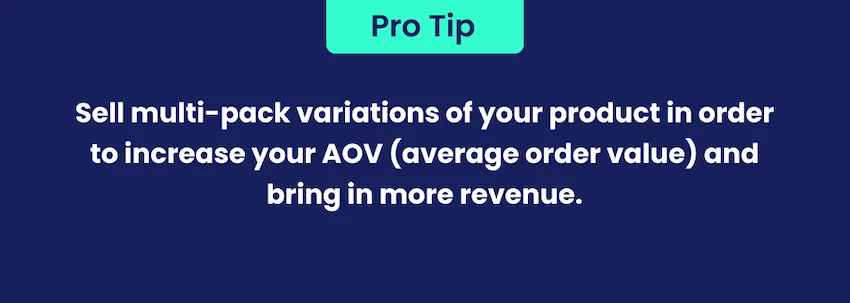
I’ll give you an example of one of the products that we sell. We sell sunglasses. And what we did is we made one-pack, three-packs, six-packs of sunglasses. People bought the three-packs! It’s the same pair of sunglasses, but they wanted to put them everywhere. And so we did that with consumables, which makes more sense.
So if you sell consumables, do this right away. Sell a one-pack. What we do is we’ll price the one pack at $30. The three-pack will be at 2.25x the price. So instead of being $90, it will be more like $70. And then we price the six-pack as a buy four get two free. And so that $30 product is then $120, but the value of that is closer to $180.
And so when we have those multipack variations, we have a higher profit margin on those multipacks. So then we can pay more, we can bid more for our cost per click when it comes to defensive product targeting.
And so for that six-pack, that’s $120. Our cost is around, let’s just say $40 for ease, and so we have $80 in profit for that product. So we can bid up to $80 in costs, before we start losing money, quote unquote. So we’ll do a high bid like $20 to $25 on our bid to then show up defensively on our own listing, because then that pushes everybody else out and if they want to beat us to bid a lot higher.
And so that’s a defensive product targeting strategy with multipack variations. That’s one of my favorite hacks that you can do and implement that will work really well.
Subscribe to the eCommerce newsletter for
top industry insights
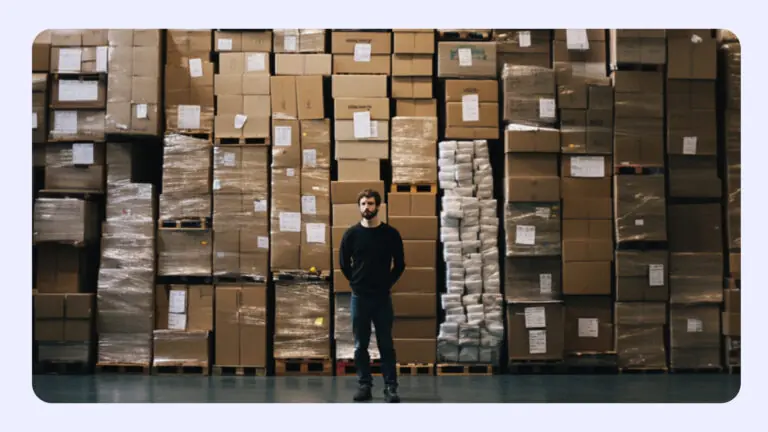
Stuck with extra inventory after Amazon’s Spring Sale? Learn five smart strategies to clear unsold stock, boost cash flow, and avoid future overstocks with smarter inventory planning.
![BFCM: The ultimate guide to eCommerce sales [2025]](https://www.8fig.co/wp-content/uploads/2023/09/cover-2-768x432.jpg.webp)
Get ready for Black Friday and Cyber Monday with our guide on maximizing sales through smart inventory management, effective marketing strategies, and leveraging eCommerce financing.
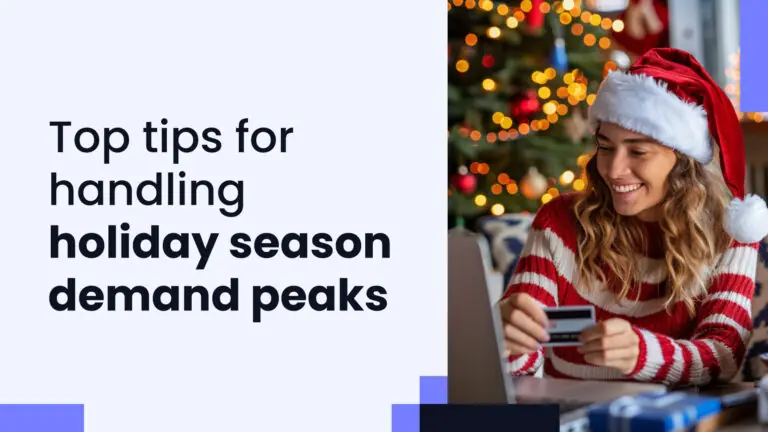
The holiday rush brings with it many challenges for eCommerce sellers. Get ahead of the competition with these top tips.
